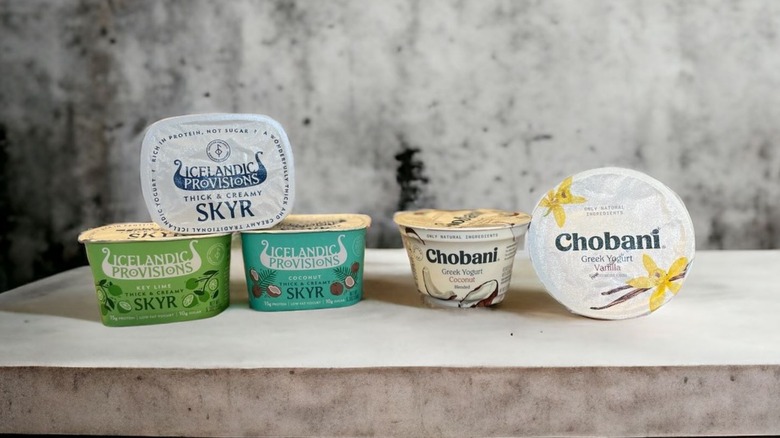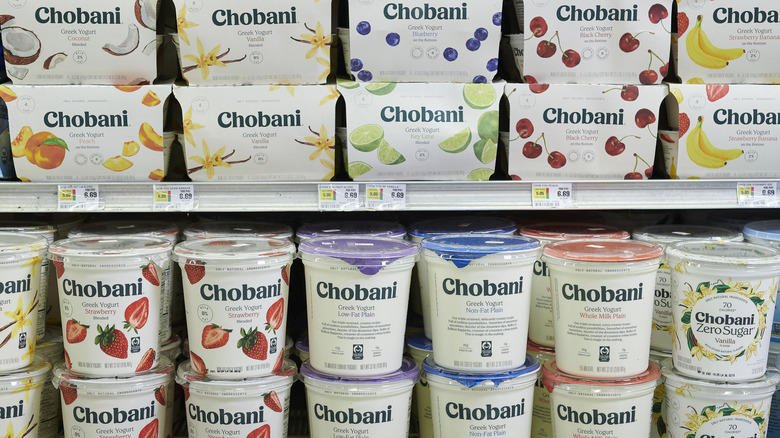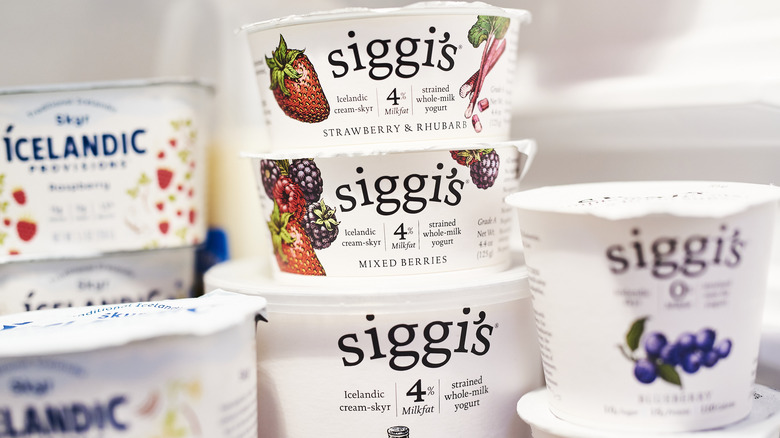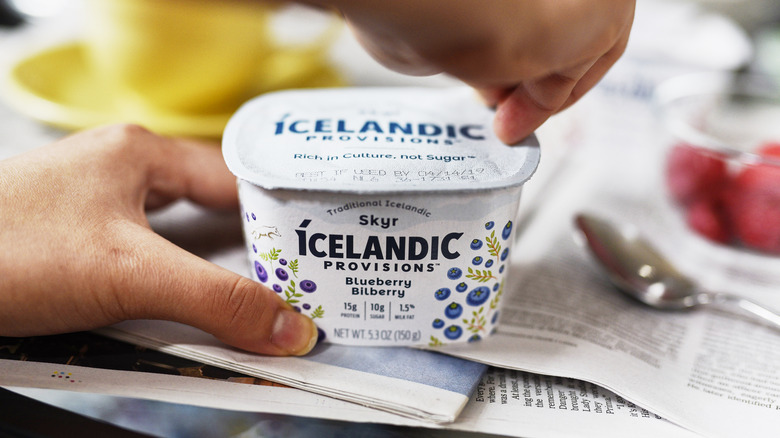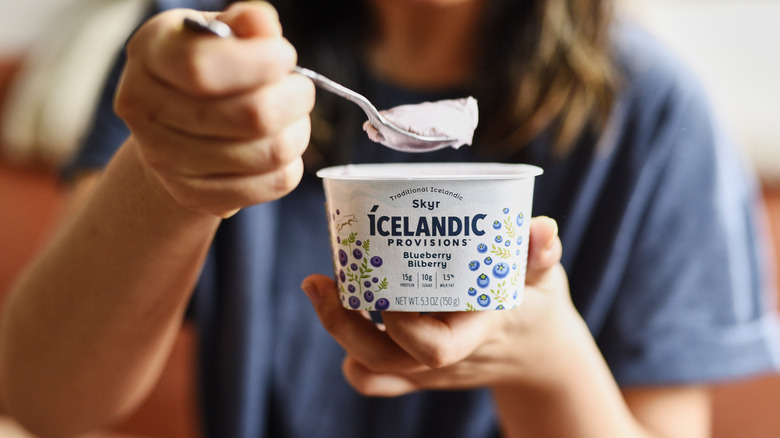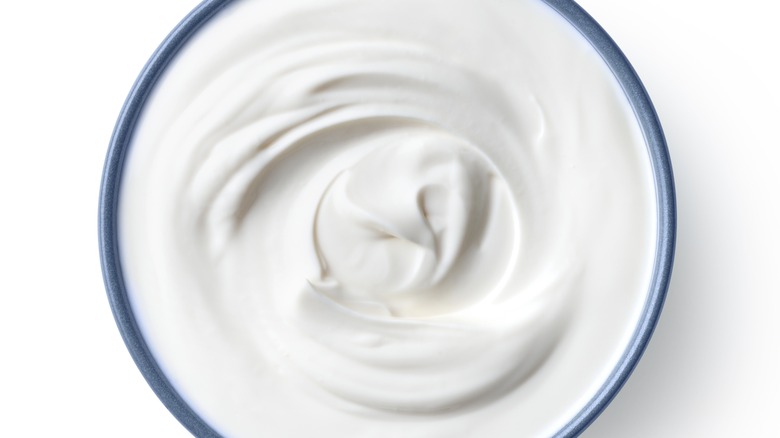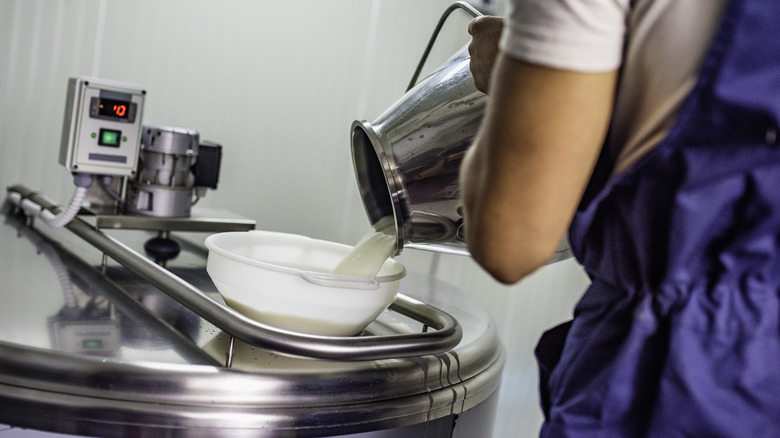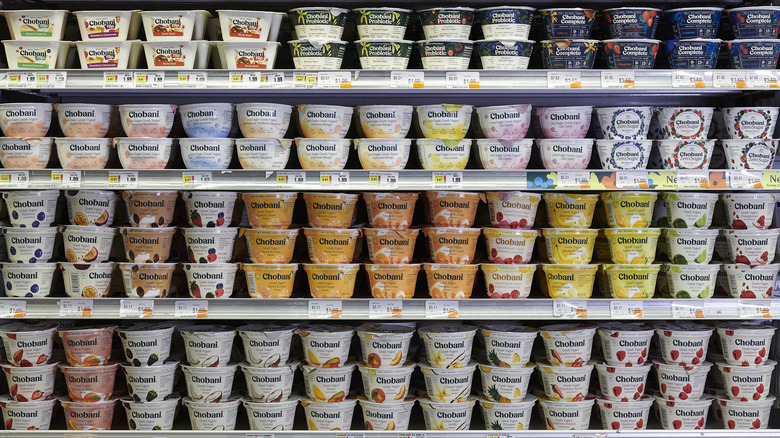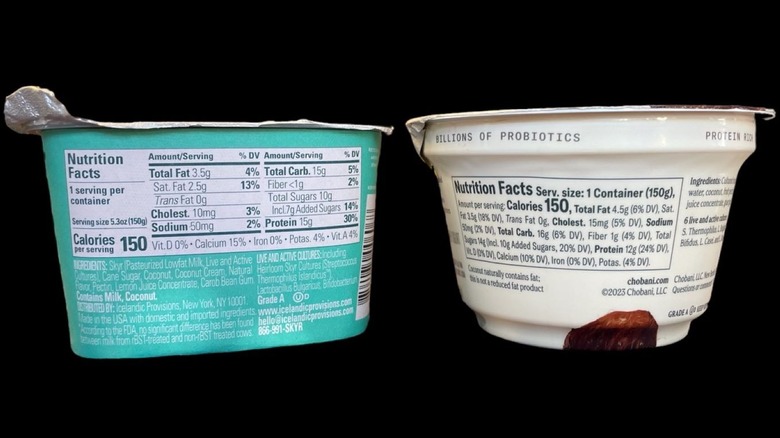What's The Difference Between Greek Yogurt And Skyr?
Skyr and Greek yogurt are quite similar. At first glance, they look the same, and they are available in the same flavors. They are also both regarded as healthy, probiotic-rich foods. While seeing their similarities is quite easy, determining their differences is not so straightforward. However, they do possess a few traits that make them stand apart. Aside from their origin, how are they different? What makes them stand out, and is one better for some instances than another? Let's find out.
To determine what makes Skyr and Greek yogurt different, I sampled several flavors of each. Trying a few of them allowed me to evaluate and compare taste, texture, appearance, and smell first-hand. I also researched their production methods, history, and more to give you a thorough explanation of each product. Keep reading to discover what I learned about the differences between Greek yogurt and Skyr — so you know which you are likely to prefer and so you can seamlessly incorporate either into your diet and recipes.
What is Greek yogurt?
Most people are familiar with Greek yogurt, even if they aren't sure exactly what it is. Compared to regular American yogurts, like Yoplait or Dannon, it is thicker, creamier, and contains more protein. However, you might be surprised to learn that Greek yogurt is just regular yogurt that goes through an additional processing step. Both kinds of yogurt start with milk. The milk is then cultured and fermented to create yogurt. The final step for Greek yogurt involves straining some of the additional liquid called whey from the curds, which explains the denser consistency and richer taste.
Surprisingly, Greek yogurt isn't actually Greek. According to Positively Probiotic, written records of yogurt in Greece date back to the 5th century BCE, but strained yogurt actually originated in the Middle East. So, why is it called Greek yogurt? The answer is simple: A clever marketing strategy. The well-known yogurt company Fage marketed strained yogurt as Greek yogurt in an effort to attract consumers and draw them away from typical American yogurt brands (via Positively Probiotic). When you think about it, it was a pretty genius move because today, everyone knows about Greek yogurt. Many people even prefer it for its nutrient-dense properties and creamy consistency.
What is Skyr?
Skyr can be found in the grocery store's dairy case, right next to other kinds of yogurt, but technically, it is not yogurt. While it looks and tastes a whole lot like other types of yogurt, Skyr is actually a strained cheese made mostly with skim but sometimes whole milk, cultures, and rennet. According to Positively Probiotic, the addition of rennet is what technically makes Skyr cheese. You can still call it yogurt, though. Everyone else does. No matter the name you use, Skyr's rich, creamy texture has made it a favorite of many.
Icelandic Provisions, one of the most recognizable producers, makes their Skyr from Icelandic heirloom cultures that have been passed down from one generation to the next for close to 1,000 years. Impressive, right? In addition to heirloom cultures, Icelandic Provisions states that it takes close to 4 cups of milk to make a single cup of Skyr. As a result, it has a much denser, creamier texture than other yogurts.
As early as 874 CE, Nordic settlers arrived in Iceland and started making Skyr (via Icelandic Provisions). Even so, it probably dates back farther than the Viking settlement of Iceland because Norway also had a Skyr-making tradition (per Positively Probiotic). No matter when it got its initial start, Skyr is considered Icelandic today.
Skyr is slightly less tangy than Greek yogurt
If you compare Skyr and Greek yogurt side by side, the difference in flavor becomes apparent after a single bite. Skyr is a little less tangy than Greek yogurt and also tends to be less sweet — overall, the flavor is more mild. The sweetness of Greek yogurt often detracts from the more potent tangy taste, but it is there nonetheless. Even so, thanks to Skyr's rich consistency, it gives you a much creamier flavor and thicker mouthfeel than Greek yogurt. So, if you prefer a bolder, tangy taste, Greek yogurt fits the bill. For a smoother, calmer taste, opt for Skyr.
Greek yogurt and Skyr have a slightly sour, tangy taste compared to regular American yogurt. The plain versions of both are rather mild overall, but they are often infused with other flavors like vanilla, coconut, fruit, and more, which significantly increase flavor. Whether you prefer plain or flavored yogurts, both Skyr and Greek yogurts are more than prepared to satisfy your cravings.
Skyr is thicker than Greek yogurt
Both Skyr and Greek yogurt are thicker than regular American yogurt. American yogurt is much runnier, and while it is still somewhat gelatinous, it can be poured from one container to another. Conversely, Greek yogurt and Skyr are too thick to pour. They have a dense texture that lies somewhere between sour cream and cream cheese.
Of the three main types of yogurt, American, Greek, and Icelandic, Skyr is the thickest. If you insert a spoon into Skyr, it basically stands up without faltering. This does not happen with Greek yogurt. It still has a dense texture, but it is no match for the viscous consistency of Skyr. The large quantity of milk used to make a small amount of Skyr is the most likely culprit for this difference. Even so, both Skyr and Greek yogurt are smooth enough to be enjoyed solo or used to make a variety of dips and sauces, like tzatziki.
Skyr and Greek yogurt look pretty similar
If you look at unlabeled containers of Skyr and Greek yogurt, it can be challenging to determine which is which just by looking at them. Both products are white and creamy looking unless, of course, fruits and other flavors that change the color have been added. If the containers are freshly opened, the surfaces of Greek yogurt and Skyr will be smooth. However, if you take a closer look, Skyr has the potential to look slightly dryer, especially around the edges. Considering Skyr is denser than Greek yogurt, this isn't all that surprising. Still, it takes a close examination to reveal this slight difference.
If you go a step further and stir Greek yogurt and Skyr, they start to show more variation regarding appearance. Greek yogurt doesn't hold peaks and crevices quite as well as Skyr. Again, this is due to the thicker texture of Skyr, but it doesn't become obvious by looking alone until you stir or extract a spoonful for closer inspection.
Greek yogurt and Skyr both have a mild aroma
Neither Greek yogurt nor Skyr have a robust aroma — they exude a mild scent reminiscent of their soured milk components. The fragrance is slightly tart. If you can call a smell tangy, that's what it would be: Slightly tangy with an undertone of sourness. Okay, don't get us wrong. It's not like we make a point of giving yogurt a good sniff before eating it. However, if you try it, you'll see what we are talking about.
The barely noticeable aroma of plain Skyr and Greek yogurt is easily overpowered when flavors are added to the mix. For example, a key lime-flavored product will exhibit a sweet smell with obvious citrusy components. Vanilla-flavored Skyr and Greek yogurt smell even sweeter still. As you probably guessed by now, berry-infused options present you with a fruity fragrance.
This might go without saying, but all of the scent descriptions apply to Greek yogurt and Skyr that are still good for eating. In other words, once they go bad, the smell becomes significantly more pronounced and develops an aroma that can be described as nothing other than sour. If you open a container of either kind of yogurt and you get a potent whiff of something rancid, chances are it has gone bad and needs to be tossed in the garbage.
The ingredients and process used to make Skyr and Greek yogurt vary slightly
Making Skyr and Greek yogurt starts with milk, but Skyr generally uses skim milk. Either way, the milk is pasteurized, which is just a fancy way to say heated to kill bacteria. Once this is done, cultures are then introduced to both products. Of course, with Skyr, they will be Icelandic cultures, but the process remains the same up until this point. Now, a major difference comes into play. Skyr also benefits from the addition of rennet, an ingredient Greek yogurt doesn't contain.
Once the ingredients are mixed together for either product, they are left to sit. This resting period gives them a chance to thicken and develop the signature tangy taste and creamy texture found in both. When enough time passes, and the milk reaches the appropriate thick consistency, the leftover liquid is strained off. Once the excess fluid, which is called whey, is separated from the other ingredients, what you're left with is a thick, creamy yogurt product.
Another thing to consider in the production process is whether or not a particular brand uses pectin or gelatin as an added thickening agent. While the presence of one over the other won't affect the flavor or texture much, it determines whether it is suitable for vegetarians, so pay close attention to the ingredients if this makes a difference to you.
Greek yogurt is often more widely available at grocery stores
Fortunately, tracking down a container of Greek yogurt or Skyr shouldn't be too difficult. Thanks to their growing popularity, both are available at grocery stores and through a myriad of online vendors. Still, Greek yogurt may be more widely available depending on where you live. Even if a store sells both kinds of yogurt, you are more likely to find several brands of Greek yogurt in one store. A few grocery stores carry Siggi's and Icelandic Provisions, the two leading brands of Skyr, but often, you'll only find one at any given store.
Greek yogurt was also challenging to find in the past, but now it is so popular you can buy it just about anywhere regular American yogurt is sold. While Skyr is still gaining traction in the American market, it has yet to reach the prevalence of Greek yogurt. However, with all it has to offer regarding its nutritional benefits and pleasing taste, this is likely to change.
Greek yogurt tends to be slightly less expensive than Skyr
Typically, Skyr and Greek yogurt are priced pretty similarly. The cost won't be exactly the same, but the difference is generally only about 30 to 50 cents, with Skyr being the more expensive of the two. For example, a single serving of Chobani Greek yogurt for $1.22. At Target, a small container of Siggi's Skyr costs $1.69, and the same size container of Chobani Greek yogurt costs $1.39.
The difference in cost between Skyr and Greek yogurt is negligible, but if you are aiming for the most cost-effective option, Greek yogurt wins. This is likely to change as Skyr becomes more popular, but for now, expect it to run you a tad bit more in the checkout line. Still, we think Skyr is worth the slight increase in price when you consider the abundance of protein and other nutritional benefits.
Can you substitute Skyr with Greek yogurt and vice versa?
Aside from eating all by itself for breakfast or as a snack, an abundance of recipes call for Greek yogurt. From zesty garnishes to rich sauces to decadent dips to Turkish-style poached eggs and more, Greek yogurt adds a tangy taste and smooth, creamy element that makes dishes unique and flavorful. Many newer recipes also use Greek yogurt in place of sour cream since it is seen as a healthier alternative. In several recipes, you can even substitute Greek yogurt for heavy cream or buttermilk. So, can you substitute Skyr for Greek yogurt in these same recipes? Absolutely, especially if you have a comparable flavor. Most of the time, recipes just use plain yogurt, but if you are making a fruity granola parfait, pretty much any flavor works.
One thing to note about making a proper Greek yogurt or Skyr substitution in any recipe is the difference in texture. If you are substituting Skyr in a recipe like French yogurt cake, which already calls for Greek yogurt, you shouldn't have any issues. The only time you may want to make some slight alterations is if you are using one of them instead of heavy cream or buttermilk. In these instances, you'll want to add a small amount of liquid and blend or mix thoroughly to mimic the consistency better.
Skyr is typically somewhat healthier than Greek yogurt
In a head-to-head comparison, skyr is considered healthier than Greek yogurt. While both products are thought of as protein-rich and more nourishing than regular American yogurt, Skyr has a bit more of the things we want and a bit less of the things we don't. Compared to Greek yogurt, Skyr has higher amounts of protein, vitamins, and minerals. It also has less sugar, fat, and carbs.
A single serving of Icelandic Provisions coconut-flavored skyr contains 3.5 total grams of fat, and the same size and flavor of Chobani Greek yogurt contains 4.5 grams. In the same containers, the Skyr has 10 grams of sugar, while the Greek yogurt has 14 grams. The Greek yogurt also has 16 grams of carbs, whereas the Skyr only has 15. Lastly, the labels pictured above show that the Greek yogurt has 12 grams of protein, which is pretty good, but the Skyr has 15, so it wins in every aspect.
After everything we've learned about Skyr's versatility, nutritional benefits, and more, it's easy to see why many people are asking, is Skyr the new Greek yogurt?

